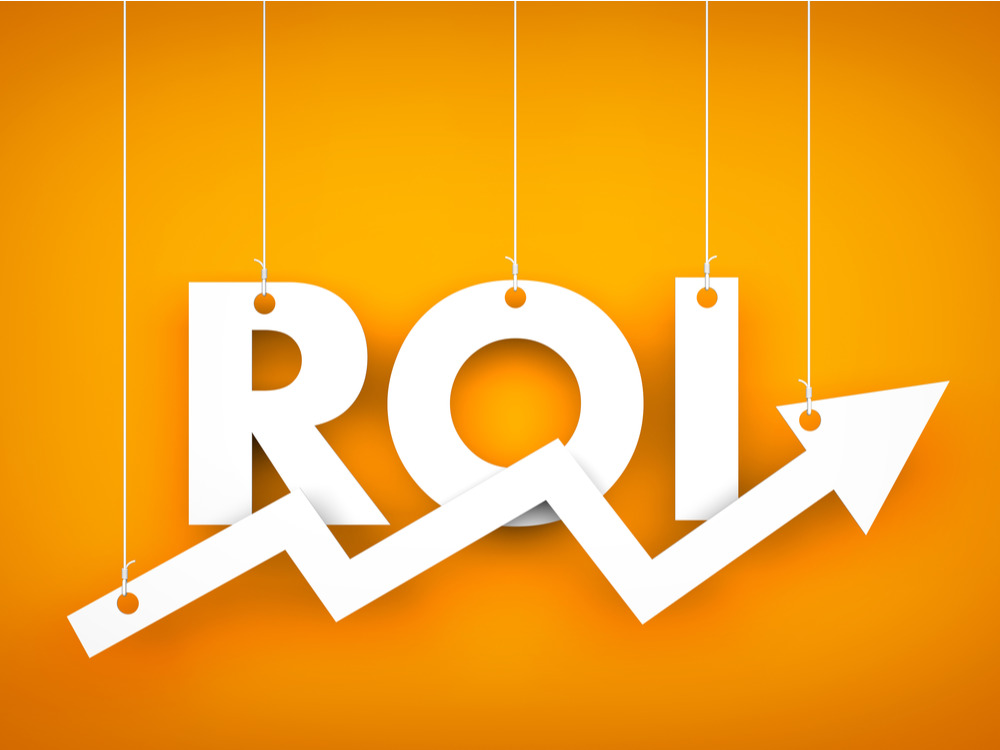Return on investment (ROI) allows you to measure the profitability of investments. That can be a straight cash investment—as is the case with measuring the ROI of stocks, investment portfolios, or asset purchases like real estate—or it can be used to measure the profitability of business endeavors.
ROI is used in 2 ways: to calculate the projected return on an investment, which is done when determining whether or not the investment is worth the cost, and the actual ROI, which is calculated after the fact to measure what kind of return you actually saw.
We’ll break down everything an entrepreneur needs to know about ROI. Once you’ve mastered investment calculation, head over to our selection of free courses to discover more ways to broaden your business acumen.
What Is Return on Investment (ROI)?
Return on investment, commonly abbreviated ROI, is a simple formula that measures the profitability of an investment. ROI essentially compares how much you made on an investment compared to how much you put into it. It’s a metric that businesses and investors use to determine the value of their investments.
For investors, ROI tends to be calculated in strictly financial terms. How much capital did you invest and how much did you get back? For businesses, ROI is often calculated using different factors. There’s the strict monetary cost of how much a business puts into a certain project or initiative, but then there are soft factors, like the time that various employees put into the project. Some of that can be measured monetarily.
For example, if an employee who makes $100,000/year spends a full month working on the project, you’d need to see a return of at least $8,333 to break even on that project. In addition to the salary costs that were dedicated to the project, there’s also the question of opportunity cost. What couldn’t the employees work on because they were dedicated to that project? Time is a finite resource, so many companies will also try to account for the time cost and the sacrifices they’ll have to make in order to pursue a given project, even though those factors can’t be measured in a quantitative way.
Ways That ROI Can Be Expressed
- As a percentage: This is the most common way we see ROI expressed because it’s the easiest to understand. If you saw a profit of $7 on a $100 investment, that would be expressed as a 7% ROI.
- As a ratio: ROI is a ratio, but we see this less commonly used because it can be difficult to understand if the ROI is less than 100%. In the example above, the ROI would be expressed in a ratio as .07:1. Weird, right? But consider an ROI of 500% or 1,000%, in those cases, it might be simpler to show your ROI as 5:1 or 10:1.
- As a multiple: Expressing ROI as a multiple is a variant of expressing it as a ratio. In the example above, you might say the ROI was 5x or 10x instead of 5:1 or 10:1. Again, this is best used for ROIs greater than 100%.
How to Calculate Your Return on Investment (ROI)
Basic ROI calculation can help you make sound financial decisions, so let’s look at the step-by-step method for how to calculate ROI.
- Begin by gathering the necessary figures that you’ll need for the ROI equation.
- Cost of the investment: Calculate the total cost of the investment. This might include capital investments, marketing investment, and salary/personnel costs that went into the investment.
- Net profit: Net profit is calculated by subtracting the investment cost from the gross profit (i.e. the total profit).
- Divide the net profit by the cost of the investment.
- Multiply the result by 100 to yield a percentage.
The ROI Formula
There are 2 formulas to calculate ROI. You can use either ROI equation.
- ROI = (Net Profit/Cost of Investment) x 100
- ROI = ([Present Value-Cost of Investment]/Cost of Investment) x 100
Both formulas will yield the same result. The second ROI formula just breaks down the steps of calculating your net profit, which is the gross profit minus the cost of the investment, before dividing it by the total cost of the investment.
Looking at an ROI equation in the abstract can feel confusing, so let’s look at how to calculate ROI with a couple of examples.
Calculating ROI for a Marketing Campaign
Making ROI-driven decisions is what can set your marketing department apart, so let’s look at how a hypothetical ecommerce company, Buy Cute Stuff, might calculate the ROI of their “Cuter Than a Basket Full of Puppies” campaign.
Cost of the Investment (Marketing Cost)
Buy Cute Stuff ran a campaign of social media ads letting their consumers know that their products are even cuter than a basket full of puppies. The company ran Facebook ads and Google ads that directed customers to a landing page. To calculate their total investment, we need to add together the total ad spend from different channels and the cost of building the marketing materials.
- Facebook ad spend: $5,000
- Google ad spend: $7,500
- Social media and ad graphics: $1,000
- Landing page creation: $700
- Total Cost of the Investment: $14,2000
Net Profit (Sales Growth)
Buy Cute Stuff’s campaign was designed to drive ecommerce sales, directly boosting revenue. To calculate the net profit of their marketing campaign, we need to look at the total revenue generated by the campaign and then subtract the total cost of the investment.
Total sales generated by the campaign: $60,000
Net Profit = $60,000 – $14,200 = $58,578
Marketing ROI = ($58,578/$14,200) x 100 = 413%
The total ROI of this campaign is 413%, which can also be expressed as a ratio (4:1) or a multiple (4x).
Another Way to Calculate Marketing ROI
Another way that marketers tend to measure ROI is through the customer lifetime value (CLV). The CLV illustrates the long-term ROI of a repeat customer. You can measure CLV with the following formula:
Customer Lifetime Value = (Retention Rate) / (1+ Discount Rate/Retention Rate)
What Is a Good ROI?
What qualifies as a good ROI varies depending on the type of investment. In marketing, 500% (aka 5:1 or 5x) is a solid ROI. 1,000% (10:1 or 10x) is considered stellar. A 200%, on the other hand, would be considered disappointing. When you invest in stocks, an annual ROI of 7% is considered the standard, and an ROI above 10% is considered good in real estate investing.
If you’re not sure whether or not your ROI is good for a given industry or project, do some market research to see what the comps are.
How to Use ROI
ROI can be used to calculate the value of pretty much any spending. It’s commonly used by investors to calculate the capital gain compared to their initial investment, and it’s used by businesses as a key performance indicator (KPI) to determine the value of different investments.
ROI helps to take the guesswork out of business decisions, giving you the information you need to make a solid investment decision. ROI is often used by businesses to determine the cash value of
- Hiring new employees
- Purchasing equipment
- Marketing efforts
- Sales strategies
- Expanding the company
- Acquiring another business
Projecting ROI for Future Business Decisions
Many businesses use ROI in a cost-benefit analysis before pursuing a new project or expenditure. As an investment formula, ROI is only as reliable as the data that you put into it. Try to be as realistic as you can about the expense involved and the total return you can expect. Like any projections, ROI can be inaccurate if the projections you use are too optimistic or too pessimistic.
When evaluating whether or not to pursue a project, you’ll also want to consider your business’s cash flow and how the required investment would affect your cash flow. If you have $10,000 in working capital, and it would cost $8,000 to purchase a new piece of equipment, that’s a risky investment because it eats up 80% of your cash—even if your projected ROI makes it seem worth it in the long run.
What Can’t ROI Do?
ROI can’t tell you anything about the risk of a potential investment. It can’t tell you if you have the money to take advantage of a new investment opportunity, and it can’t tell you if a digital marketing campaign supports your overall marketing strategy. Can ROI measure your team’s job satisfaction? Nope. It can’t do that either.
In short, ROI doesn’t allow for nuance. It’s a single factor that should be considered when weighing the pros and cons of an investment opportunity, but it should never be the sole basis for a financial decision.
Are ROI and IRR the Same?
Many people wonder whether ROI is the same as an Internal Rate of Return (IRR) because IRR is commonly referred to as the “return on investment.” However, ROI and IRR vary in the way that they’re calculated. IRR provides more nuance, but because it’s more complicated to calculate, it tends to only be used for capital investments (and usually only by investing professionals).
What Is Annualized ROI?
Annualized ROI is the process of measuring the average ROI of an investment on an annual basis. Long-term investments like stocks and real estate tend to be calculated in annualized ROI.
The formula for measuring annualized ROI is a bit more complicated than the basic ROI calculation. Here’s how to measure annualized ROI:
Annualized ROI = {[1 + (Net Profit / Cost of Investment)] (1/Number of Years Investment is Held) – 1} x 100
Using Annualized ROI for an Investment Property
If an investor has purchased real estate as an investment, they’ll often use an annualized ROI for measuring the profitability of the investment. This is because real estate tends to be held for a number of years, and the cost of the investment is often annualized. If you’re buying a rental property, you’ll either take out a mortgage that annualizes the cost of the property or you’ll pay cash. But even if you pay cash for the property, the cost of the asset (including the property cost and closing costs) will likely be amortized over the number of years you hold it. This will be offset by the appreciation of the asset over time, combined with the rental income that the property generates.
Take Your Financial Knowledge Up a Notch
Now that you know the ins and outs of ROI, it’s time to make sure that your knowledge of other business finance topics is up to snuff. Take the Finance for Founders course to level up your expertise, so you can make informed financial decisions in every area of your business.
The post What Is ROI? And How Can You Calculate It like a Pro? appeared first on Foundr.




















